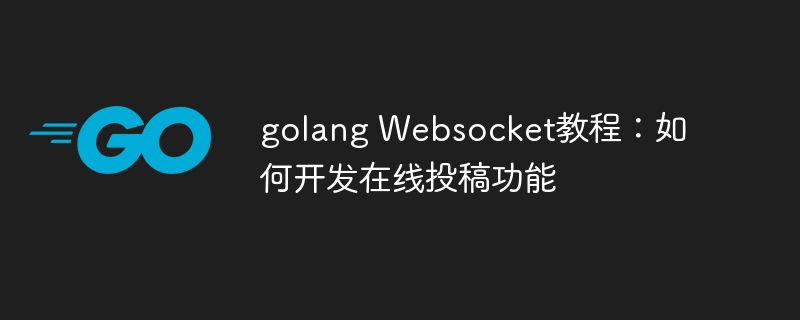Home >Backend Development >Golang >golang Websocket tutorial: How to develop online submission function
golang Websocket tutorial: How to develop online submission function
- 王林Original
- 2023-12-17 10:23:211218browse

Golang Websocket Tutorial: How to develop online submission function
Introduction:
With the rapid development of the Internet, more and more applications need to achieve real-time communication Function. In network applications, Websocket technology has become a commonly used communication protocol. This article aims to teach readers how to use Golang language to develop an online submission function and use Websocket to achieve real-time interaction.
1. Introduction to Websocket
Websocket is a full-duplex communication protocol that can establish a persistent connection between the browser and the server to achieve real-time communication. Compared with the traditional HTTP protocol, Websocket has lower latency and higher throughput, and is suitable for application scenarios that process real-time data.
2. Development environment setup
Before starting development, you need to set up the Golang development environment.
- Install Golang: Visit the official website https://golang.org/doc/install to download and install the Golang version suitable for your operating system.
-
Install related libraries:
go get github.com/gorilla/websocket
3. Project structure design
Before developing the online submission function, you need to plan the directory structure of the project.
- main.go - handler.go - template - index.html
4. Code implementation
-
main.go
package main import ( "html/template" "log" "net/http" "github.com/gorilla/websocket" ) var ( upgrader = websocket.Upgrader{} clients = make(map[*websocket.Conn]bool) broadcast = make(chan []byte) homeTemplate *template.Template ) func homeHandler(w http.ResponseWriter, r *http.Request) { homeTemplate.Execute(w, nil) } func websocketHandler(w http.ResponseWriter, r *http.Request) { conn, err := upgrader.Upgrade(w, r, nil) if err != nil { log.Println(err) return } defer conn.Close() clients[conn] = true for { _, msg, err := conn.ReadMessage() if err != nil { log.Println(err) delete(clients, conn) return } broadcast <- msg } } func handleMessages() { for { msg := <-broadcast for client := range clients { err := client.WriteMessage(websocket.TextMessage, msg) if err != nil { log.Println(err) client.Close() delete(clients, client) } } } } func main() { // 配置文件路径 homeTemplate = template.Must(template.ParseFiles("template/index.html")) http.HandleFunc("/", homeHandler) http.HandleFunc("/ws", websocketHandler) go handleMessages() err := http.ListenAndServe(":8080", nil) if err != nil { log.Fatal(err) } } -
handler.go
package main import ( "net/http" "path/filepath" ) func homeHandler(w http.ResponseWriter, r *http.Request) { filePath, _ := filepath.Abs("template/index.html") http.ServeFile(w, r, filePath) } -
template/index.html
<!DOCTYPE html> <html> <head> <meta charset="UTF-8"> <title>在线投稿功能</title> </head> <body> <h1>在线投稿功能</h1> <textarea id="message-input" rows="5" cols="30"></textarea> <button id="send-btn">发送</button> <br> <ul id="message-list"></ul> </body> <script> var socket = new WebSocket("ws://localhost:8080/ws"); socket.onmessage = function (event) { var messageList = document.getElementById("message-list"); var messageItem = document.createElement("li"); messageItem.innerText = event.data; messageList.appendChild(messageItem); }; document.getElementById("send-btn").addEventListener("click", function () { var messageInput = document.getElementById("message-input"); var message = messageInput.value; socket.send(message); }); </script> </html>
5. Run the test
-
Enter the project directory on the command line and execute the following command Start the server:
go run main.go
- Open the browser and enter the address http://localhost:8080/ to access the page.
6. Summary
Through the above steps, we have completed the development of an online submission function based on Golang. Real-time message delivery is realized through Websocket. After the user enters the message in the text box and clicks the send button, the message can be sent to the server and displayed on the page instantly.
Continuing to learn and practice Websocket related technologies will bring more possibilities and innovations to development. I hope readers can use the guidance of this article to better use Golang to develop more real-time and interactive network applications.
The above is the detailed content of golang Websocket tutorial: How to develop online submission function. For more information, please follow other related articles on the PHP Chinese website!

